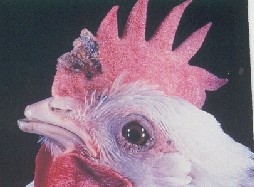Pox viruses are single, linear, double stranded DNA viruses which cause chronic disease in poultry of all species and age.
Mosquito bites and mechanical transmission of virus to lacerated skin or eye are common routes of viral spread. Wild birds are a reservoir for the viruses.
Incubation period is from 4-10 days. They are two forms of the disease; the cutaneous or dry and the diphtheritic or wet. Both may be present in the same flock or animals.
The dry form shows as a pimple or scab on skin (mainly comb, wattles, eyelids and other unfeathered portions of the body).
The wet-mucous form shows diphtheritic, cankers or yellow lesions in mouth, oesophagus or trachea. Eye involvement (blindness), off feed, lower egg production, facial swelling and an increase in culls can be seen.
Cankers or false membranes in mouth (wet) are seen as slightly elevated white opaque nodules. Nodules increase in size and coalesce to yellow, cheesy, and necrotic membranes.
Grey or black papular eruptions on unfeathered portions of skin (dry) are due to epithelial hyperplasia. Head, face, and feet are most commonly affected, but may spread to feathered portions of the body.
Eliminate bacterial dermatitis. Virus isolation on CAM of embryos will produce plaques, which will reveal intracytoplasmic inclusion bodies. Gross lesions will reveal inclusion bodies. Presence of scales on skin and cankers in the mouth in the fall of the year is an important characteristic of the disease.
Vaccination in ovo with recombinant vaccines or in pullets by wing web puncture.
 Occurrence: Worldwide.
Occurrence: Worldwide.
